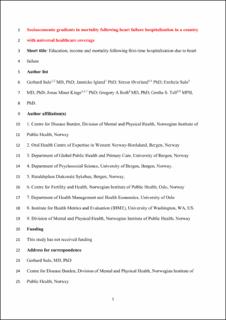| dc.contributor.author | Sulo, Gerhard | |
| dc.contributor.author | Igland, Jannicke | |
| dc.contributor.author | Øverland, Simon Nygaard | |
| dc.contributor.author | Sulo, Enxhela | |
| dc.contributor.author | Kinge, Jonas Minet | |
| dc.contributor.author | Roth, Gregory A. | |
| dc.contributor.author | Tell, Grethe S. | |
| dc.date.accessioned | 2021-05-25T09:01:35Z | |
| dc.date.available | 2021-05-25T09:01:35Z | |
| dc.date.created | 2020-11-10T11:47:27Z | |
| dc.date.issued | 2020 | |
| dc.Published | JACC. Heart failure. 2020, 8 (11), 917-927. | |
| dc.identifier.issn | 2213-1779 | |
| dc.identifier.uri | https://hdl.handle.net/11250/2756203 | |
| dc.description.abstract | Objectives
This study explored the association between socioeconomic position (SEP) and long-term mortality following first heart failure (HF) hospitalization.
Background
It is not clear to what extent education and income—individually or combined—influence mortality among patients with HF.
Methods
This study included 49,895 patients, age 35+ years, with a first HF hospitalization in Norway during 2000 to 2014 and followed them until death or December 31, 2014. The association between education, income, and mortality was explored using Cox regression models, stratified by sex and age group (35 to 69 years and 70+ years).
Results
Compared with patients with primary education, those with tertiary education had lower mortality (adjusted hazard ratio [HR]: 0.89; 95% confidence interval [CI]: 0.78 to 0.99 in younger men; HR: 0.57; 95% CI: 0.43 to 0.75 in younger women; HR: 0.90; 95% CI: 0.84 to 0.97 in older men, and HR: 0.87; 95% CI: 0.81 to 0.93 in older women). After adjusting for educational differences, younger and older men and younger women in the highest income quintile had lower mortality compared with those in the lowest income quintile (HR: 0.63; 95% CI: 0.55 to 0.72; HR: 0.78; 95% CI: 0.63 to 0.96, and HR: 0.91; 95% CI: 0.86 to 0.97, respectively). The association between income and mortality was almost linear. No association between income and mortality was observed in older women.
Conclusions
Despite the well-organized universal health care system in Norway, education and income were independently associated with mortality in patients with HF in a clear sex- and age group-specific pattern. | en_US |
| dc.language.iso | eng | en_US |
| dc.publisher | Elsevier | en_US |
| dc.rights | Attribution-NonCommercial-NoDerivatives 4.0 Internasjonal | * |
| dc.rights.uri | http://creativecommons.org/licenses/by-nc-nd/4.0/deed.no | * |
| dc.title | Socioeconomic gradients in mortality following HF hospitalization in a country with universal health care coverage | en_US |
| dc.type | Journal article | en_US |
| dc.type | Peer reviewed | en_US |
| dc.description.version | acceptedVersion | en_US |
| dc.rights.holder | Copyright 2020 Elsevier | en_US |
| cristin.ispublished | true | |
| cristin.fulltext | postprint | |
| cristin.qualitycode | 1 | |
| dc.identifier.doi | 10.1016/j.jchf.2020.05.015 | |
| dc.identifier.cristin | 1846508 | |
| dc.source.journal | JACC. Heart failure | en_US |
| dc.source.pagenumber | 917-927 | en_US |
| dc.identifier.citation | JACC. Heart failure. 2020, 8(11), 917-927 | en_US |
| dc.source.volume | 8 | en_US |
| dc.source.issue | 11 | en_US |


